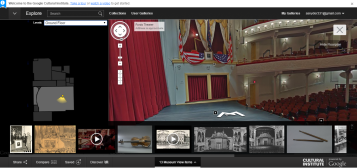The Importance of the Digital World in Public History
Typically, when people think of public history (after finally understanding what exactly it entails), their minds are drawn to physical museums and historic sites, be it somewhere as well-known as a Smithsonian or something more remote, such as a small, locally run museum; however, that is not all there is.
As the world grows more reliant on the internet for information, public historians have learned to adapt to this new forum as well. A museum’s physical location inherently limits the audience it can reach as only those with the right proximity or monetary resources can feasibly visit. An online exhibit or a digitized archive, on the other hand, can be accessed from anywhere with an internet connection. Technology has the ability to empower history in a way that physical sites and printed words never could; it makes history much more open and accessible.
The goal of public historians is often to reach as many people as possible and digitization can aid in this process.
- Digitized archival material means “to those who previously had no access, online archives open locked doors,” such as all the resources available on Internet Archive.
- Digitizing collections is “about taking cultural heritage collections and changing them. Changing what we can do with them. Changing how we see them. Changing how we think about them, even the ones they don’t intend to display.”
- Mobile apps can “foster a new, robust relationship between the twenty-first-century communities we serve and the collections we care for.”
Online exhibits are one of the best and easiest ways to truly get history to the public. They are not only reachable to many people, but are often free and fairly easy for the institution to create—a must for museums with small budgets. Further, they are no less curated than a physical exhibit and in some cases, you can even virtually walk through the entire museum.
Last year, I worked at Ford’s Theatre as their digital public history intern. My time spent there enabled me to see just how critical the internet can be for museums. I created three online exhibits using Google Cultural Institute, I wrote blogs, and contributed to Remembering Lincoln, their new online collection of responses to the Lincoln assassination, all of which brought the story of Abraham Lincoln’s life and legacy to thousands of people who live outside of Washington, D.C. After about 9 months, my blogs had over 3,000 views, and after just a few months, the first two of my exhibits had nearly 11,000 views! While Ford’s Theatre is a popular tourist spot and does not need to worry about visitorship or public recognition, this cannot be said for many smaller museums. And in those cases, utilizing online spaces can greatly benefit the site.

You can walk through Ford’s Theatre and virtually stand on the stage–something you can’t even normally do while visiting the site.

Or you can zoom in to look at John Wilkes Booth’s derringer in incredible detail!
People are sometimes skeptical about relying so heavily on digital technology, and often for good reasons. However, for public historians, this online world is certainly one worth exploring.